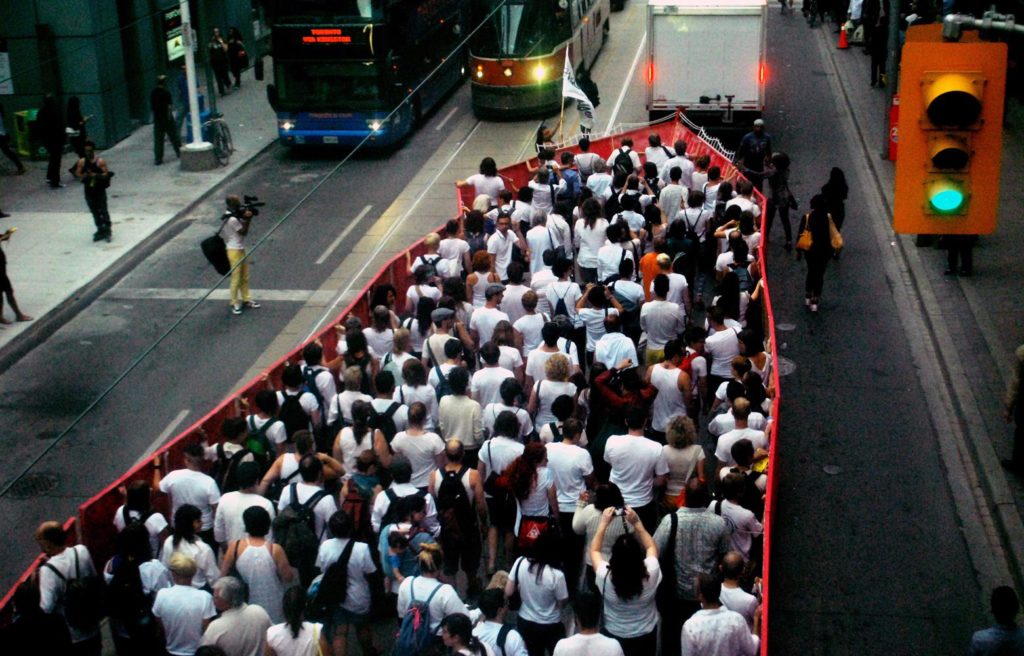Above Whippersnapper Gallery‘s tiny Toronto storefront at the edge of Kensington Market, the colourful plywood bow of a boat emerges from the brick facade. It’s part of the project Mass Arrival, a public intervention and installation by Farrah Miranda, Graciela Flores, Tings Chak, Vino Shanmuganathan and Nadia Saad that aims to provoke questions about the way different narratives of migration are shaped by racial bias.
In the August 12 public intervention—staged on the anniversary of the 2010 MV Sun Sea arrival off the BC coast, after which 492 Sri Lankan Tamil refugees were detained—a giant plywood ship stopped traffic at Yonge and Queen in front of Toronto’s downtown Bay store and Eaton Centre. Constructed in sections and held together by participants, the ship contained a mass of people who had responded to a call for white-identified volunteers. Carrying a white flag emblazoned with the hashtag #massarrival, the artists spoke to the gathered crowd, contextualizing the intervention as an attempt to question Canadian identity and ask who gets to belong here. After a brief time, the performance dispersed.
A graphic created in relation to the performance asked, “How does this mass arrival of white people make you feel?,” and the action certainly yielded varied reactions from onlookers and performers. Torontoist writer Desmond Cole reported on Twitter that a bystander said “go back to your own country” as he passed the ship, adding that the participants “should all be arrested.” Cole also noted in a blog post that one passerby (with some horror) took it to be an advocacy event for a white-only settlement in Canada; she demonstrated relief once the project intent was explained.
The installation component of the project at Whippersnapper Gallery is an attempt to make such reactions material within the gallery space.
Inside, three video screens cycle through footage of the intervention and of news coverage of the arrival of the MV Sun Sea. The walls are plastered with printouts from floor to ceiling. Some reproduce news stories related to the state of immigration law in Canada: stories of arrivals, scandals, public outcry and reactionary law-making. (An example of the latter is the 2012 change to Bill C-31, which was criticized by the Canadian Civil Liberties Association and Amnesty International, among others, for imposing unreasonable time limits on refugee claims also mandating immediate one-year imprisonment for group arrivals.)
Other printouts are of online narratives about the arrival of white colonists like Jacques Cartier, Henry Hudson and Pierre Lemoyne d’Iberville—stories told in strikingly different modes than those used in describing today’s mass arrivals. And yet other pages are full of emails, Tweets, Facebook posts and comment threads the artists received in response to the project. Reflecting on the presence of social media in contemporary activism, the printouts quickly make concrete the discussion circulating in the social media ether.
Rather than simply performing a racial or ethnic substitution—a one-off role reversal of skin colour and lived experience—the project presents a nuanced interrogation of racism, settlement, embodiment and allyship. Both the artists and the participants were rendered vulnerable throughout the process of the performance, depending on each other’s direction and cooperation to realize the project. Contrasting the struggles of today’s immigrants to Canada with the heroic, trailblazing narratives that often accompany historical tales of settlement, the project holds the two as interlinked, reflecting on whiteness as a socially legitimized determinant of belonging.
The most intriguing element of “Mass Arrival” is perhaps its element of accountability and its investment in continued dialogue. During the exhibition, which continues to September 28, the artists invite visitors to respond to items pasted on the walls in red pencil; they are also holding a public dialogue on September 18 from 7 to 9 p.m. at Double Double Land.
Giving candid voice to gallery visitors regardless of their stance on the project (and according them the corresponding responsibility for their words by refusing to redact their contact information from printed emails), “Mass Arrival” is not simply a spectacle that responds in kind to the spectacle of mass immigration. It is a project that foregrounds public participation as a means of counteracting the silent acceptance of colonial narratives, while also acknowledging (through the inclusion of online naysayers) the impossibility of the gesture as a cure-all. Xenophobia, discomfort and earnestness all reveal themselves here.









